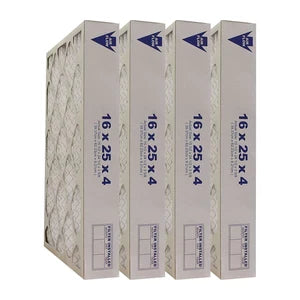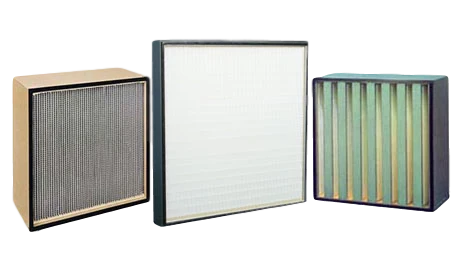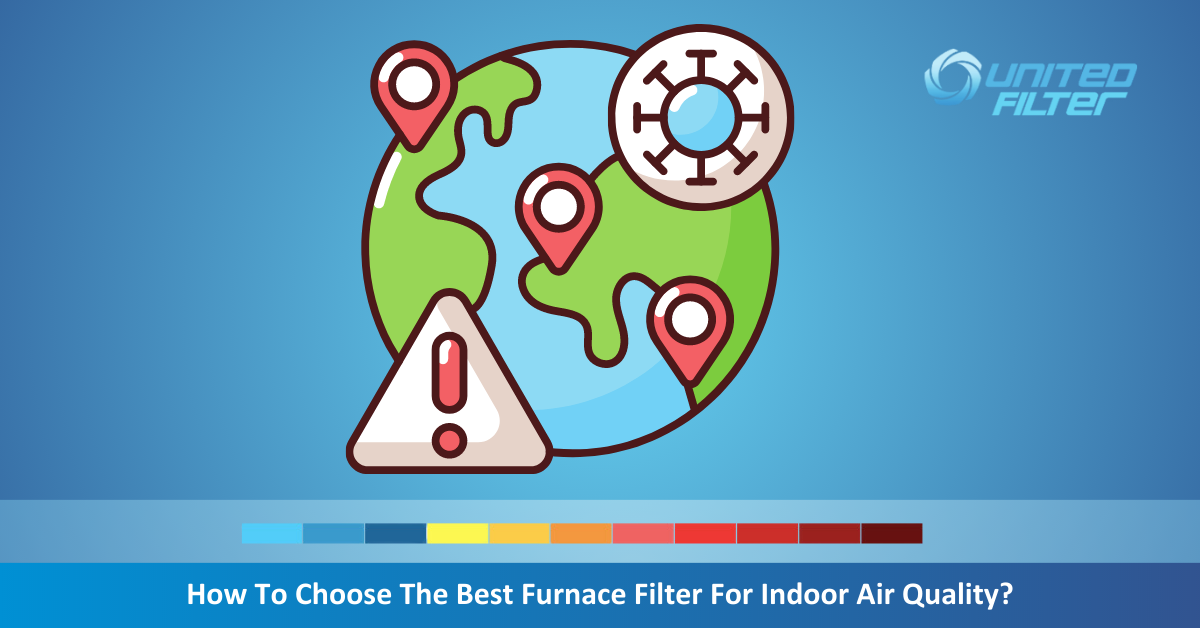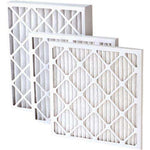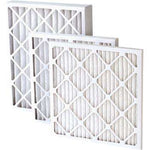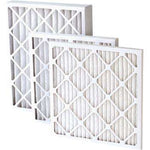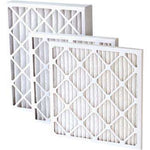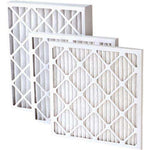You have no items in your shopping cart.
 Choosing a furnace filter can be confusing. There are different types and sizes, and each one has its own special features that make it work better than others. That’s why we’ve put together this guide to help you understand the variety of options available on the market today.
Choosing a furnace filter can be confusing. There are different types and sizes, and each one has its own special features that make it work better than others. That’s why we’ve put together this guide to help you understand the variety of options available on the market today.
At the end of this post, we'll give our recommendation for which filters are best for indoor air quality!
The first step in choosing a furnace filter is to determine what size you need.
The first step in choosing a filter is to determine what size you need. Filters come in different lengths and widths, so it's important to check your furnace's specifications before buying one. The size of your filter will be determined by the size of your furnace's air intake port, which can be found on the side or back of the unit (depending on how old or new it is).
Carbon Monoxide's Impact on Indoor Air Quality

Carbon monoxide is a common byproduct of burning fuels, including wood and gasoline. It's odorless, colorless, and can cause serious health problems if you're exposed to too much of it. For example, carbon monoxide poisoning can result in headaches and nausea—but the symptoms aren't always so obvious; they may include dizziness or even death.
Many experts recommend installing a carbon monoxide detector in your home to keep an eye on levels of this gas in your air. Carbon monoxide detectors should be replaced every five years to ensure they remain effective at detecting harmful levels of CO2 in your home.
Why Measure Carbon Dioxide Inside Buildings?

The measurement of carbon dioxide levels inside buildings is important because indoor carbon dioxide concentrations can be high. The EPA's recommended level for carbon dioxide indoors is 1,000 ppmv (parts per million by volume), or about .1%. But the average level of carbon dioxide in a typical office building is between 1,200 and 1,500 ppmv—that’s about twice as much as what’s recommended for healthful breathing!
Air that contains higher than normal levels of carbon dioxide can cause headaches and fatigue as well as nausea and dizziness. It also suppresses your immune system, making you more susceptible to colds and flu viruses. Furthermore, research has linked indoor air pollution with increased risk for heart disease, lung cancer and SIDS (sudden infant death syndrome).
Indoor Carbon Dioxide Levels and Your Health

The reason for this is simple: we breathe out carbon dioxide as a waste product when we exhale, but not all of it goes away through air vents or windows. The more people are in an enclosed space—like your family room or office building—the more carbon dioxide builds up in that space. It doesn't go away until you either open up windows or use fans to get rid of some of it (or both). It's important to note that there are no hard-and-fast rules about how much CO2 is considered safe or healthy; what matters most is how many hours you spend in any given day inside an area with high indoor CO2 levels.
What indoor air filter is best for allergens?
In the section above, we discussed the difference between HEPA, electrostatic and pleated furnace filters.
Now let's talk about what filter is best for your allergies.
A few things to consider:
-
Are you looking for a furnace filter that will trap allergens? If so, then you want an electrostatic or pleated furnace filter with a high MERV rating (more on this below). These types of filters are excellent at trapping pollen, dust mites and pet dander. They are also easy to install and can be cleaned using soap and water or in the dishwasher.
- Do you prefer a disposable filter? If so, look for one with double pleats which will provide better filtration than single-pleat models. Also ensure that it includes anti-microbial additives like silver ions or zeolite clay – these help prevent mold growth inside the filter itself!
The MERV rating System
 The MERV rating system is a standard for measuring how well a furnace filter traps certain particle sizes.
The MERV rating system is a standard for measuring how well a furnace filter traps certain particle sizes.
The letters M, E, R and V stand for the following:
- M = Most effective filtration in terms of removing dusts
- E = Efficiency of aerosol particles removal
- R = Resistance to airflow restriction by the filter media (not relevant to whole house air filters)
- V = Velocity through the medium of an air filter when used with an electric blower at 150 FPM (feet per minute).
When shopping for a furnace filter, keep in mind that not all filters are the same. Some are disposable while others are reusable.
When shopping for a furnace filter, keep in mind that not all filters are the same. Some are disposable while others are reusable.
Disposable filters cost more to buy but they are easier to install since they don't need cleaning or maintenance before each use. However, if you have allergies or suffer from asthma, using disposable filters could be a problem because they tend to clog up with dust and other particles over time.
Reusable filters can be cleaned and reused if you follow the manufacturer's instructions carefully. This may be preferable for people who have pets or who live in dusty areas because it's possible to remove any build-up from the filter before putting it back into service (although this is more difficult than just throwing away an old one). Reusable filters may also cost less money over time as well as being better for the environment than regular disposable options because of reduced landfill waste!
If your home’s air quality is poor, a furnace filter with a high MERV rating may help by filtering out more airborne particles.
If you live in a home with poor air quality, a furnace filter with a high MERV rating may help by filtering out more airborne particles.
A MERV rating is an industry standard for measuring filter efficiency. These ratings are often used to determine which type of filter is best for your home's needs. The higher the MERV rating, the better able it will be at removing dust, pollen and other airborne particles from the air you breathe—and thus improve indoor air quality in your home. However, there are several things to keep in mind when choosing a furnace filter based on its MERV rating:
- It’s not just size that matters - a higher-rated MERV filter can remove smaller particle sizes than lower-rated ones (such as those rated at 2 or 5). If you want to purify your entire house’s indoor environment using filters instead of expensive ductwork replacement (like HVAC professionals often recommend), this might be an important factor when deciding what kind of furnace filter will work best for your household budget and space constraints.
- Heavier-duty filters require less frequent replacement but aren't ideal if you're limited on storage space; lighter weight ones have shorter life spans but take up less room inside your HVAC unit.
- Some filters lack "layers" within their construction which traps small particles like dust mites before they reach human lungs.* High efficiency doesn't mean heavy duty—there may be some overlap between these two categories depending on how frequent we replace them.* A high performance level does not necessarily mean longer lasting either - this could depend upon how big & dirty area being cleaned
Although higher-rated MERV filters can cost more, they may be the best choice if your family has allergies or asthma.
The higher the MERV rating, the more efficient your filter will be at preventing particles from escaping into the air you breathe. Lower-rated filters are less expensive but may not provide enough protection for families with allergies or asthma. If you have pets, you may need a higher-rated filter to keep their dander from getting through and irritating your respiratory system.
Choosing the right furnace filter may help improve your home’s air quality by capturing lint and dust particles before they enter your home.
As you can see, there are many factors to consider when choosing which furnace filter is right for your home. The best furnace filter is the one that best fits your particular needs and lifestyle.
The next step in your research process is to decide where you’ll be buying your replacement furnace filters from. Do they have a good return policy? What warranties do they offer on their products? How long has this company been in business? These are all important questions to ask before placing an order with any company, but especially if you’re planning on spending hundreds of dollars each year on new filters!
Conclusion
In addition, if you have allergies or asthma, you may want to invest in a furnace filter that has a high MERV rating. These types of filters are more expensive but will provide better protection from allergens and other harmful particles because they capture more dust than lower-rated filters do. If money is tight and you aren't sure if this is the right choice for your home's indoor air quality, it may be worth getting one with a lower MERV rating instead.
 Choosing a furnace filter can be confusing. There are different types and sizes, and each one has its own special features that make it work better than others. That’s why we’ve put together this guide to help you understand the variety of options available on the market today.
Choosing a furnace filter can be confusing. There are different types and sizes, and each one has its own special features that make it work better than others. That’s why we’ve put together this guide to help you understand the variety of options available on the market today.
At the end of this post, we'll give our recommendation for which filters are best for indoor air quality!
The first step in choosing a furnace filter is to determine what size you need.
The first step in choosing a filter is to determine what size you need. Filters come in different lengths and widths, so it's important to check your furnace's specifications before buying one. The size of your filter will be determined by the size of your furnace's air intake port, which can be found on the side or back of the unit (depending on how old or new it is).
Carbon Monoxide's Impact on Indoor Air Quality

Carbon monoxide is a common byproduct of burning fuels, including wood and gasoline. It's odorless, colorless, and can cause serious health problems if you're exposed to too much of it. For example, carbon monoxide poisoning can result in headaches and nausea—but the symptoms aren't always so obvious; they may include dizziness or even death.
Many experts recommend installing a carbon monoxide detector in your home to keep an eye on levels of this gas in your air. Carbon monoxide detectors should be replaced every five years to ensure they remain effective at detecting harmful levels of CO2 in your home.
Why Measure Carbon Dioxide Inside Buildings?

The measurement of carbon dioxide levels inside buildings is important because indoor carbon dioxide concentrations can be high. The EPA's recommended level for carbon dioxide indoors is 1,000 ppmv (parts per million by volume), or about .1%. But the average level of carbon dioxide in a typical office building is between 1,200 and 1,500 ppmv—that’s about twice as much as what’s recommended for healthful breathing!
Air that contains higher than normal levels of carbon dioxide can cause headaches and fatigue as well as nausea and dizziness. It also suppresses your immune system, making you more susceptible to colds and flu viruses. Furthermore, research has linked indoor air pollution with increased risk for heart disease, lung cancer and SIDS (sudden infant death syndrome).
Indoor Carbon Dioxide Levels and Your Health

The reason for this is simple: we breathe out carbon dioxide as a waste product when we exhale, but not all of it goes away through air vents or windows. The more people are in an enclosed space—like your family room or office building—the more carbon dioxide builds up in that space. It doesn't go away until you either open up windows or use fans to get rid of some of it (or both). It's important to note that there are no hard-and-fast rules about how much CO2 is considered safe or healthy; what matters most is how many hours you spend in any given day inside an area with high indoor CO2 levels.
What indoor air filter is best for allergens?
In the section above, we discussed the difference between HEPA, electrostatic and pleated furnace filters.
Now let's talk about what filter is best for your allergies.
A few things to consider:
-
Are you looking for a furnace filter that will trap allergens? If so, then you want an electrostatic or pleated furnace filter with a high MERV rating (more on this below). These types of filters are excellent at trapping pollen, dust mites and pet dander. They are also easy to install and can be cleaned using soap and water or in the dishwasher.
- Do you prefer a disposable filter? If so, look for one with double pleats which will provide better filtration than single-pleat models. Also ensure that it includes anti-microbial additives like silver ions or zeolite clay – these help prevent mold growth inside the filter itself!
The MERV rating System
 The MERV rating system is a standard for measuring how well a furnace filter traps certain particle sizes.
The MERV rating system is a standard for measuring how well a furnace filter traps certain particle sizes.
The letters M, E, R and V stand for the following:
- M = Most effective filtration in terms of removing dusts
- E = Efficiency of aerosol particles removal
- R = Resistance to airflow restriction by the filter media (not relevant to whole house air filters)
- V = Velocity through the medium of an air filter when used with an electric blower at 150 FPM (feet per minute).
When shopping for a furnace filter, keep in mind that not all filters are the same. Some are disposable while others are reusable.
When shopping for a furnace filter, keep in mind that not all filters are the same. Some are disposable while others are reusable.
Disposable filters cost more to buy but they are easier to install since they don't need cleaning or maintenance before each use. However, if you have allergies or suffer from asthma, using disposable filters could be a problem because they tend to clog up with dust and other particles over time.
Reusable filters can be cleaned and reused if you follow the manufacturer's instructions carefully. This may be preferable for people who have pets or who live in dusty areas because it's possible to remove any build-up from the filter before putting it back into service (although this is more difficult than just throwing away an old one). Reusable filters may also cost less money over time as well as being better for the environment than regular disposable options because of reduced landfill waste!
If your home’s air quality is poor, a furnace filter with a high MERV rating may help by filtering out more airborne particles.
If you live in a home with poor air quality, a furnace filter with a high MERV rating may help by filtering out more airborne particles.
A MERV rating is an industry standard for measuring filter efficiency. These ratings are often used to determine which type of filter is best for your home's needs. The higher the MERV rating, the better able it will be at removing dust, pollen and other airborne particles from the air you breathe—and thus improve indoor air quality in your home. However, there are several things to keep in mind when choosing a furnace filter based on its MERV rating:
- It’s not just size that matters - a higher-rated MERV filter can remove smaller particle sizes than lower-rated ones (such as those rated at 2 or 5). If you want to purify your entire house’s indoor environment using filters instead of expensive ductwork replacement (like HVAC professionals often recommend), this might be an important factor when deciding what kind of furnace filter will work best for your household budget and space constraints.
- Heavier-duty filters require less frequent replacement but aren't ideal if you're limited on storage space; lighter weight ones have shorter life spans but take up less room inside your HVAC unit.
- Some filters lack "layers" within their construction which traps small particles like dust mites before they reach human lungs.* High efficiency doesn't mean heavy duty—there may be some overlap between these two categories depending on how frequent we replace them.* A high performance level does not necessarily mean longer lasting either - this could depend upon how big & dirty area being cleaned
Although higher-rated MERV filters can cost more, they may be the best choice if your family has allergies or asthma.
The higher the MERV rating, the more efficient your filter will be at preventing particles from escaping into the air you breathe. Lower-rated filters are less expensive but may not provide enough protection for families with allergies or asthma. If you have pets, you may need a higher-rated filter to keep their dander from getting through and irritating your respiratory system.
Choosing the right furnace filter may help improve your home’s air quality by capturing lint and dust particles before they enter your home.
As you can see, there are many factors to consider when choosing which furnace filter is right for your home. The best furnace filter is the one that best fits your particular needs and lifestyle.
The next step in your research process is to decide where you’ll be buying your replacement furnace filters from. Do they have a good return policy? What warranties do they offer on their products? How long has this company been in business? These are all important questions to ask before placing an order with any company, but especially if you’re planning on spending hundreds of dollars each year on new filters!
Conclusion
In addition, if you have allergies or asthma, you may want to invest in a furnace filter that has a high MERV rating. These types of filters are more expensive but will provide better protection from allergens and other harmful particles because they capture more dust than lower-rated filters do. If money is tight and you aren't sure if this is the right choice for your home's indoor air quality, it may be worth getting one with a lower MERV rating instead.
